.
Prelude
Messolonghi was first besieged by the Ottomans in 1822. The Ottomans blockaded the city from the sea with their navy and their infantry and artillery bombarded the walls. However, the daring Admiral Andreas Miaoulis with his group of ships kept on slipping in and out of the city to bring supplies. Amongst the defenders was Lord Byron. In late 1824, the Ottomans retreated to their bases in Thessaly. In 1825, however, Lord Byron died of an illness.
The Siege
Shortly after Byron's death in 1825, the Turks came to besiege the Greeks again. The commander of the Turks, Reşid Mehmed Pasha was joined by Ibrahim Pasha who crossed the Gulf of Corinth. During the early part of 1826, Ibrahim had more artillery and supply brought in. However, his men were unable to storm the walls. The High Commissioner of the Ionian Islands, Sir Frederick Adam, tried to make both forces sign a treaty, but his efforts were unsuccessful. The Greek Admiral Andreas Miaoulis kept breaking through the Turkish naval blockade and bringing in supplies. However, when the Turks captured the fortress island of Anatolikon, Miaoulis was not able to bring in supplies.
The Escape Plan
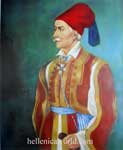
Notis Botsaris (Νώτης Μπότσαρης)
The situation soon became desperate for the defenders. After around a year of holding out the leaders of the Greeks, Notis Botsaris, Kitsos Tzavelas and Makris made a plan to escape the city. Georgios Karaiskakis would attack the Turks from the rear and create a diversion while the besieged Greeks would escape the city. Of the 9,000 inhabitants only 7,000 were strong enough to take part. The people that stayed behind knew they had a certain fate.
The Escape
The Muslims had been made aware of the escape plan by traitors. When the refugees charged out of the city gates they were fired upon by Muslims from defensive positions. Many of the Greeks panicked and fled inside the walls. Of the 7,000 people that tried to escape only 1,000 made it to safety. The next morning Palm Sunday the Turks entered the city. Many of the Greeks killed themselves by blowing themselves up with gunpowder rather than surrender.[citation needed] The rest of the Greeks were slaughtered or sold into slavery.[citation needed] The Turks displayed 3,000 severed heads off the walls.[citation needed]
Aftermath
After this incident many people from western Europe felt sympathy for the Greek cause. Within four years Missolonghi fell into Greek hands again.
|
Third Siege of Messolonghi
|
|
|
Part of Greek War of Independence
|
|
| Date | 15 April 1825 - 10 April 1826 |
| Location | Messolonghi, Greece |
| Result | Ottoman victory |
|
Combatants
|
|
| Greek revolutionaries | Ottoman Empire Egypt |
|
Commanders
|
|
| Notis Botsaris | Reşid Mehmed Pasha Ibrahim Pasha |
|
Strength
|
|
| 5,000 | 20000 Ottomans 15000 Ottoman auxiliaries ca. 15000 Egyptians |
|
Casualties
|
|
| 8000 soldiers and civilians | |
Sources
Peter Parouakis. The Greeks: Their Struggle for Independence. ISBN 0-9590894-0-3

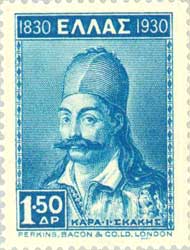
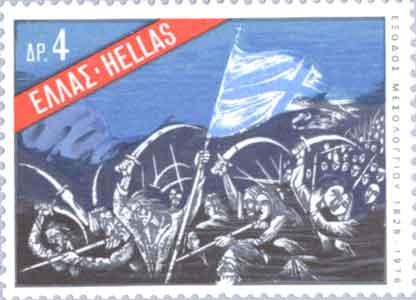
Sortie from Missolonghi"
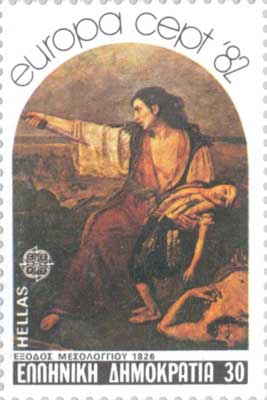
E. de Lunsac "Scene from the sortie from Missolonghi"
Weblinks
Theodoros P. Vryzakis , The sortie from Missolonghi
Museum of the History and Art of the Municipality of the Holy City of Missolonghi
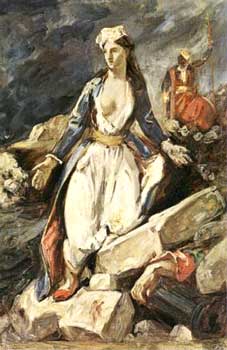
Liberty on the Ruins of Messolonghi, Delacroix
The Byron Chronology, 1823-4 Greece and Missolonghi
| Ancient Greece
Science, Technology , Medicine , Warfare, , Biographies , Life , Cities/Places/Maps , Arts , Literature , Philosophy ,Olympics, Mythology , History , Images Medieval Greece / Byzantine Empire Science, Technology, Arts, , Warfare , Literature, Biographies, Icons, History Modern Greece Cities, Islands, Regions, Fauna/Flora ,Biographies , History , Warfare, Science/Technology, Literature, Music , Arts , Film/Actors , Sport , Fashion --- |
Retrieved from "http://en.wikipedia.org"
All text is available under the terms of the GNU Free Documentation License

